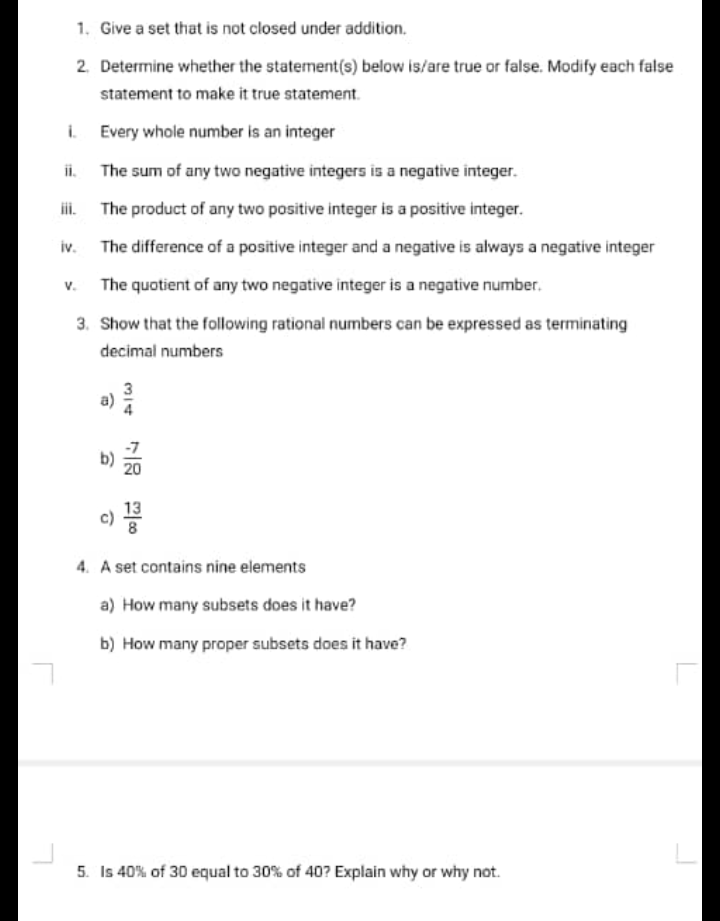2. Determine whether the statement(s) below is/are true or false. Modify each false statement to make it true statement. i. Every whole number is an integer The sum of any two negative integers is a negative integer. i. i. The product of any two positive integer is a positive integer. iv. The difference of a positive integer and a negative is always a negative integer v. The quotient of any two negative integer is a negative number. 3. Show that the following rational numbers can be expressed as terminating decimal numbers a) b) 13 c) 8 4. A set contains nine elements a) How many subsets does it have? b) How many proper subsets does it have?
2. Determine whether the statement(s) below is/are true or false. Modify each false statement to make it true statement. i. Every whole number is an integer The sum of any two negative integers is a negative integer. i. i. The product of any two positive integer is a positive integer. iv. The difference of a positive integer and a negative is always a negative integer v. The quotient of any two negative integer is a negative number. 3. Show that the following rational numbers can be expressed as terminating decimal numbers a) b) 13 c) 8 4. A set contains nine elements a) How many subsets does it have? b) How many proper subsets does it have?
Algebra: Structure And Method, Book 1
(REV)00th Edition
ISBN:9780395977224
Author:Richard G. Brown, Mary P. Dolciani, Robert H. Sorgenfrey, William L. Cole
Publisher:Richard G. Brown, Mary P. Dolciani, Robert H. Sorgenfrey, William L. Cole
Chapter2: Working With Real Numbers
Section2.1: Basic Assumptions
Problem 40WE
Related questions
Topic Video
Question
100%

Transcribed Image Text:1. Give a set that is not closed under addition.
2. Determine whether the statement(s) below is/are true or false. Modify each false
statement to make it true statement.
i. Every whole number is an integer
ii The sum of any two negative integers is a negative integer.
li. The product of any two positive integer is a positive integer.
iv.
The difference of a positive integer and a negative is always a negative integer
The quotient of any two negative integer is a negative number.
3. Show that the following rational numbers can be expressed as terminating
decimal numbers
b)
20
13
8
4. A set contains nine elements
a) How many subsets does it have?
b) How many proper subsets does it have?
5. Is 40% of 30 equal to 30% of 40? Explain why or why not.
m14
Expert Solution
This question has been solved!
Explore an expertly crafted, step-by-step solution for a thorough understanding of key concepts.
This is a popular solution!
Trending now
This is a popular solution!
Step by step
Solved in 4 steps with 4 images

Knowledge Booster
Learn more about
Need a deep-dive on the concept behind this application? Look no further. Learn more about this topic, algebra and related others by exploring similar questions and additional content below.Recommended textbooks for you

Algebra: Structure And Method, Book 1
Algebra
ISBN:
9780395977224
Author:
Richard G. Brown, Mary P. Dolciani, Robert H. Sorgenfrey, William L. Cole
Publisher:
McDougal Littell

Holt Mcdougal Larson Pre-algebra: Student Edition…
Algebra
ISBN:
9780547587776
Author:
HOLT MCDOUGAL
Publisher:
HOLT MCDOUGAL

Elementary Linear Algebra (MindTap Course List)
Algebra
ISBN:
9781305658004
Author:
Ron Larson
Publisher:
Cengage Learning

Algebra: Structure And Method, Book 1
Algebra
ISBN:
9780395977224
Author:
Richard G. Brown, Mary P. Dolciani, Robert H. Sorgenfrey, William L. Cole
Publisher:
McDougal Littell

Holt Mcdougal Larson Pre-algebra: Student Edition…
Algebra
ISBN:
9780547587776
Author:
HOLT MCDOUGAL
Publisher:
HOLT MCDOUGAL

Elementary Linear Algebra (MindTap Course List)
Algebra
ISBN:
9781305658004
Author:
Ron Larson
Publisher:
Cengage Learning